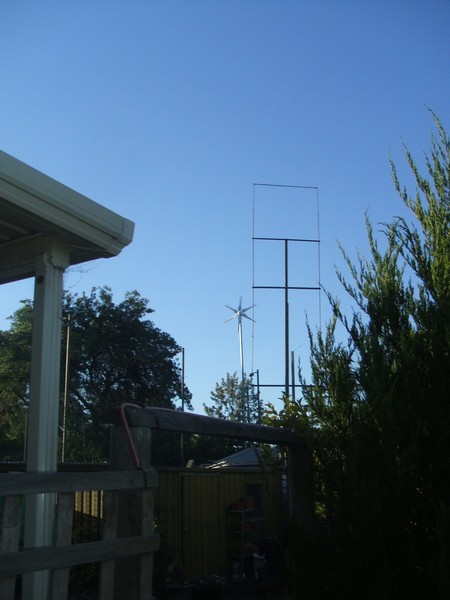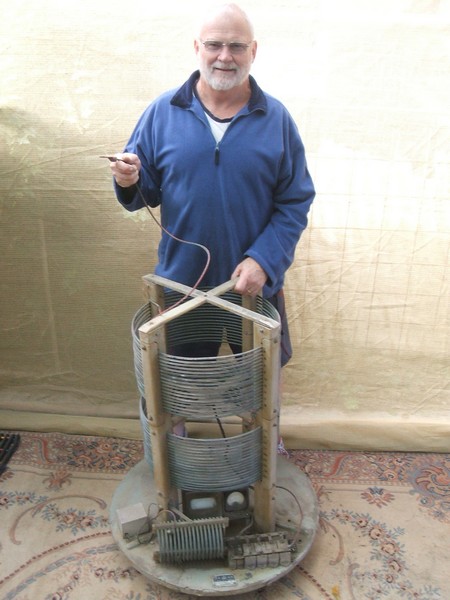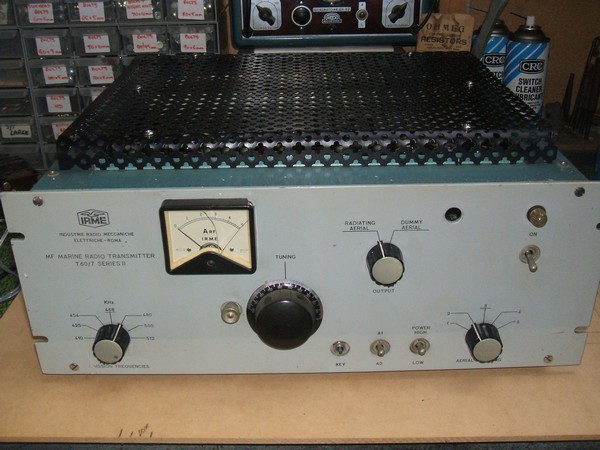VK5BUG's keys.
Introduction.
 Greetings from Down Under...
Greetings from Down Under...
It was back in the late 1960s that I practiced sending Cootie, bug & straight key CW by 'phantom' keying to mimic various taped CW activity from the shore stations where I worked (VHK & VHM), particularly when assigned the CW Broadcast to ships watchkeeping role.
I would punch up the autohead tapes that keyed the station transmitters & with the aid of a monitoring Murphy B40 receiver & the original message copy at hand, was able to practice my hand sending aiming for precise synch with the outgoing broadcast.
This was to ingrain both rhythm & spacing, usually @ 22wpm which was the basic Royal Australian Navy operating speed at the time.
Once back at sea, I decided that practising along with a metronome, and also music of diverse tempos to match keying speed, would assist in providing a sound timing base. I still do that from time to time though I thought it was much more necessary back then.
When some of my Navy colleagues saw & heard what I was doing, someone publicised the concept & referred to me by the 'nickname' "Beethoven" which has stuck ever since.
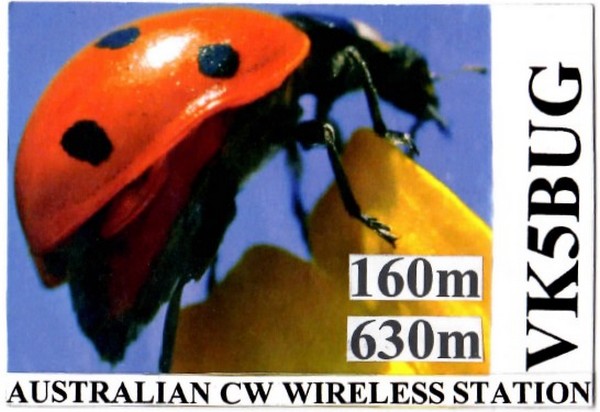
VK5BUG's 160/630m 2015 QSL card, recto. |
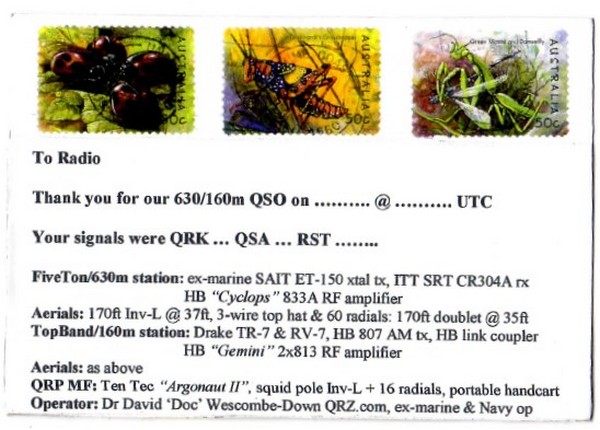
VK5BUG's 160/630m 2015 QSL card, verso. |
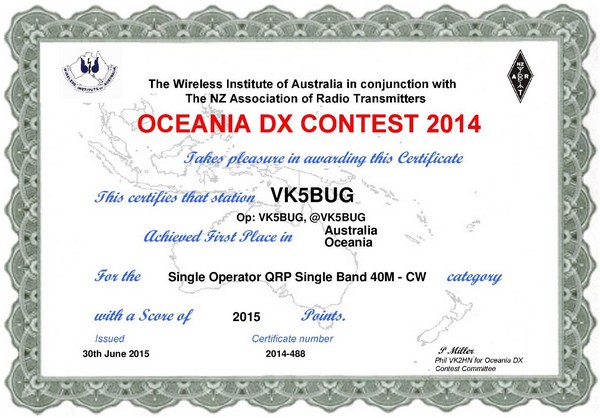
2014 OCDX contest certificate, VK5BUG first place in single operator QRP single band 40m CW category. |
Pictures from left to right:
- My 500Khz Italian marine transmitter running 4 x 25DQ6Bs with another as the MCW modulator bottle. It runs off 24V & works fine. I have a bunch of ex-WW2 FT241 crystals for the 630m band but have to tickle the oscillator circuitry as the xtals are of a very different cut to the originals in the circuit. It is not unusual for FT241 rocks NOT to oscillate in more modern circuits.
- "That's not an aerial coupler...THIS IS an aerial coupler!!!" My 630/2200m base loading setup.
- My 300W wind turbine (part of the solar-wind hybrid 12V power system to my QRP station) & 28MHz Extended Double Zepp Loop aerial (6dBd bidirectional).
All my Cootie keys & one of my semi-automatic bugs are homemade, as are all of my aerials, & there are two basic reasons for this:
- An age-pensioner, amateur radio is no longer a hobby at which I can afford to throw money.
- Although not as shiny & slick, my custom made items invariably work better than any similar commercial items I have yet encountered & reflect the "do-it-yourself" aspects of amateur radio as I know it. There are many items I am not able to make, particularly without training in solid state technology, so I grab every opportunity to do what I can for myself & only shop out what I cannot. I also enjoy the challenge of problem-solving by recycling items & using hand tools, Dremel, arc welder etc that I have.
[VK5BUG].
Homebrew Cootie Key #1.
Description.
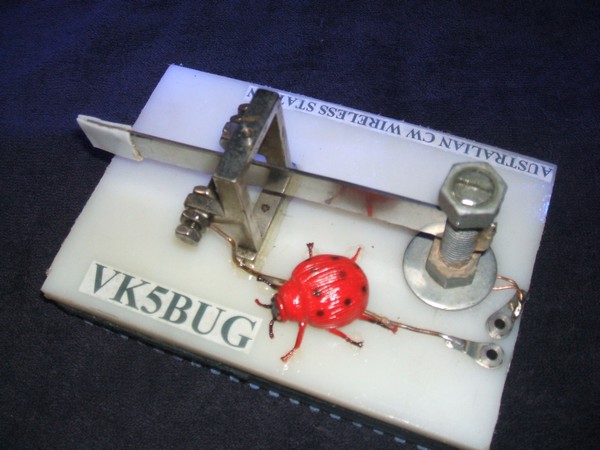
- This item has a 180 x 120mm white polyethylene kitchen cutting board base, a piece of 13mm plywood with non-skid rubber webbing (ex-caravan kitchen products) all glued as a sandwich. As we have a small caravan, the roll of cheap ($2) non-skid webbing has fulfilled a number of our demands & I bet that the manufacturers never envisaged that preventing Morse key desk slippage would be one of those!!!
- An old ex-commercial bug key yoke/gantry holds the adjustable left & right contacts.
- One stainless steel ex-breadknife blade section, durable & not too whippy, provides more precise Morse symbol formation when used between the contacts spaced 2 or 3mm apart on each side.
- A chunky 12mm galvanized bolt, with countersunk head, has been sliced vertically with a hacksaw for part of its length to accept the knife blade. A top retaining nut and Araldite epoxy adhesive maintain support integrity.
- Hard drawn copper wire & solder lugs are used for the exposed point-to-point wiring.
- Cable connections are via a pair of countersunk banana plug sockets wired to the bolt & contacts, with corresponding jacks fitted to the transmitter key cable.
- Height from desktop to the finger pad top edge is 60mm.
Comments.
This key provides a nice firm "swish" (Swiss???? Hi Hi!) movement that is comfortable to use consistently @ 20-22wpm for entire 24-hour contests. I use it flat on the desk OR held by one hand in my lap & keyed with the other hand, just as we had to do aboard “small ships and big seas!!” (minesweepers, patrol boats & rescue craft). Due to the rocking knife blade armature stiffness & contact spacing, this key generates a very audible "click clack" which obviates the need for sidetone monitoring in my situation. Some would find that annoying, while it is comforting to me. [VK5BUG].
Homebrew Cootie Key #2.
Description.
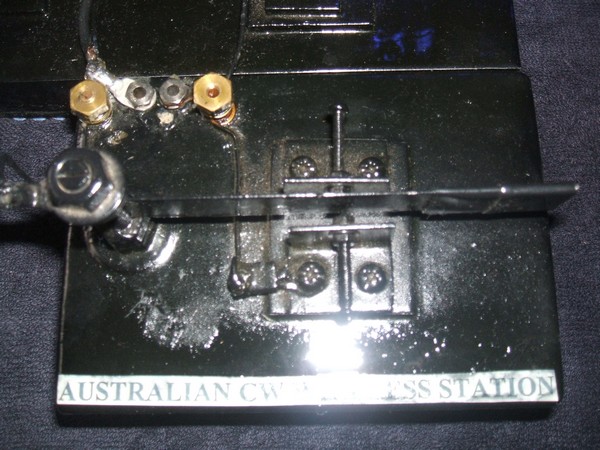
- The 140 x 100mm painted pine base & sheet of 3mm lead are glued to a piece of non-slip rubber webbing (as for Key #1).
- The height from desktop to finger pad top edge is 70mm.
- Contacts are a pair of 2.5mm diameter stainless steel bolts with ends filed to points, set in 2 back-to-back pieces of 25mm light gauge alloy angle.
- An 8mm steel bolt was cut vertically with a hacksaw as the carrier of a 120mm length of "very used" hacksaw blade. A top retaining nut & Araldite epoxy adhesive keep it in place (as for Key #1).
- A pair of countersunk banana jack sockets is shared with Key #3 to connect both keys in parallel to the transmitter via a keying cable.
- Hard drawn copper wire & solder lugs are used for exposed point-to-point wiring.
Comments.
This particular key provides a much quieter, softer & more flexible "swish" movement. It therefore suits a gentler touch, but is more susceptible to blade "buzzing" & blurring of dits if operated above about 20wpm. There is no free lunch in Cootie key construction! However, its purpose is to give me a real operational contrast to the other keys without disturbing my rhythm, and this is particularly valuable when working operators preferring 10-18wpm reception. The other firmer action keys provide more fulcrum/leverage for faster operation of crisp Morse code. [VK5BUG].
Homebrew Cootie Key #3.
Description.
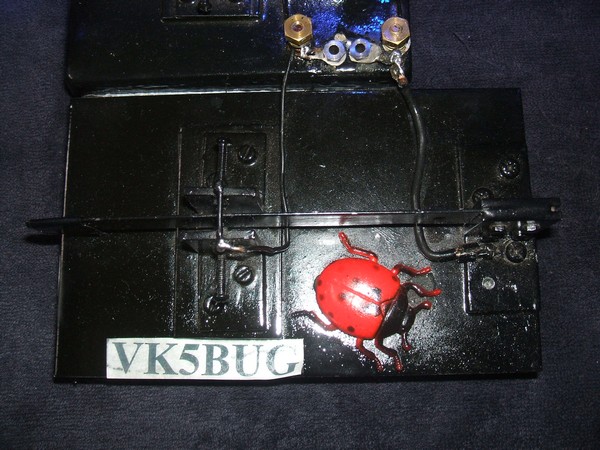
- The physically largest of my three Cootie keys @ 185 x 115mm overall. An 18mm slab of alloy is glued to a piece of 13mm ply to which non-slip rubber webbing has been glued to prevent desktop creep (as for Keys #1 & #2).
- The keying height is 65mm, so I have the choice of different heights as well as firmness in operation with which to play: a hobby is meant to be fun, right??
- Two pieces of back-to-back 25mm lightweight alloy angle are used to retain the stainless steel ex-carving knife blade armature, with another two pieces fitted with 2.5mm diameter stainless steel bolts filed to points as the contacts (as for Key #2).
- A pair of banana jack sockets are shared with Key #2 to connect both keys in parallel to the transmitter of choice.
- Hard drawn copper wire & solder lug are used for the point-to-point surface wiring.
Comments.
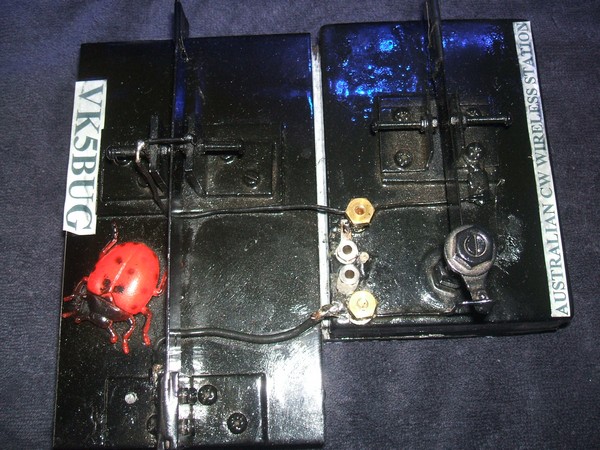 Another very positive action key with distinctive generation of "click clacks" when used. Its physical size allows me to really hang off the keying arm when hammering Morse at about 22-30wpm. For anything above that I will use my Vibroplex "Champion" semi-automatic bug.
[VK5BUG].
Another very positive action key with distinctive generation of "click clacks" when used. Its physical size allows me to really hang off the keying arm when hammering Morse at about 22-30wpm. For anything above that I will use my Vibroplex "Champion" semi-automatic bug.
[VK5BUG].
Summary.
As a professional telegraphist now operating in the amateur radio world populated by more and more electronic keyers (used with quite diverse ability levels, I would suggest!), I LOVE Cootie keys for preserving the art/craft/science of authentic straight key Morse code production. Trying to send copybook-spaced code WITHOUT producing "swing" is always my aim.
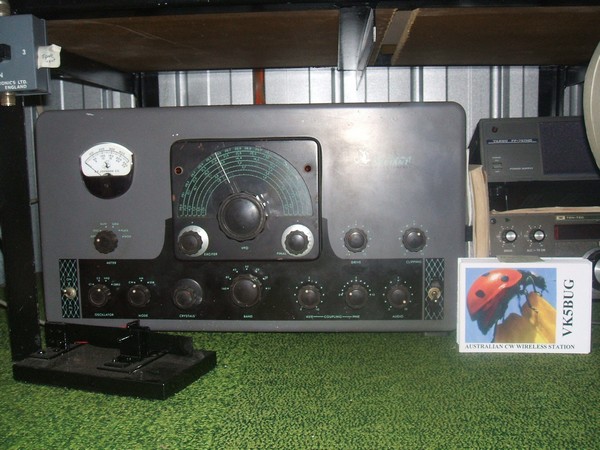 Since keying analysis for operator identification was used by all wartime participants, any of us trained in military systems were forbidden to develop unique keying characteristics and traits, simply to reduce compromising who was on which ship or establishment through how they sent Morse code traffic. For example, before being allowed to use either/both the Cootie key or bug on live Navy circuits, I had to sit a one-on-one transmitting test, sending a specifically prepared exercise of 1000 Morse symbols @ 22wpm, error-free and off-air to the Chief Radio Supervisor of Darwin Naval Radio Station. It contained plain language, random five-figure numerical groups, random five-letter groups, random five-character groups and punctuation symbols. His written endorsement allowed me to use both types of key without challenge at every subsequent posting.
Since keying analysis for operator identification was used by all wartime participants, any of us trained in military systems were forbidden to develop unique keying characteristics and traits, simply to reduce compromising who was on which ship or establishment through how they sent Morse code traffic. For example, before being allowed to use either/both the Cootie key or bug on live Navy circuits, I had to sit a one-on-one transmitting test, sending a specifically prepared exercise of 1000 Morse symbols @ 22wpm, error-free and off-air to the Chief Radio Supervisor of Darwin Naval Radio Station. It contained plain language, random five-figure numerical groups, random five-letter groups, random five-character groups and punctuation symbols. His written endorsement allowed me to use both types of key without challenge at every subsequent posting.
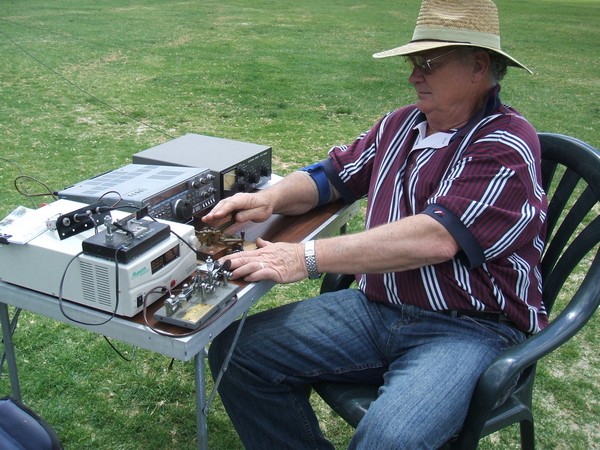 However, when I studied with the Marconi School of Wireless in Sydney (1969-71) for the First Class Commercial Certificate of Proficiency (25wpm standard), I noticed right away that there was no scrutiny for, or insistence on having no unique keying characteristics, swing etc. “Different horses for different courses!”
However, when I studied with the Marconi School of Wireless in Sydney (1969-71) for the First Class Commercial Certificate of Proficiency (25wpm standard), I noticed right away that there was no scrutiny for, or insistence on having no unique keying characteristics, swing etc. “Different horses for different courses!”
While trawling through my nostalgia I found a you tube clip from our Club's 2013 ILLW combined with the VK/ZL annual military Remembrance Day contest. We ferried across to nearby Kangaroo Island & Cape Willoughby lighthouse where a number of simultaneous stations/frequencies were activated for the whole weekend. VK5BAR is the club callsign for the Adelaide Hills Amateur Radio Society. The key I am using is the Carving Knife blade model, homebrew cootie key #3. Contest operation is a bit different to normal QSOs for me & you will no doubt detect the very audible "click clack" of the SS blade to which I referred in the above paragraph. [VK5BUG].
